Pink Quill Plant: Tillandsia Cyanea Growing Guide
This sweet little gem sure has a big bloom. They’re much smaller than the other commonly sold bromeliads, like the Aechema and Guzmania, but their bright pink flower stalk makes up for that. The Pink Quill Plant is an easy and tough houseplant that thrives in many home environments.
What makes this plant so cool, along with the big bloom in proportion to the size of the plant, is that it’s usually seen for sale in a pot but also grows as an air plant. I’ve even seen it clustered in a large (2′) kissing ball form and as kokodama.
Botanical Name: Tillandsia cyanea (old) Wallisia cyanea (new classification) Common Name: Pink Quill, Pink Quill Plant
This post may contain affiliate links, you can read our policies here.
Pink Quill Plant Care Tips
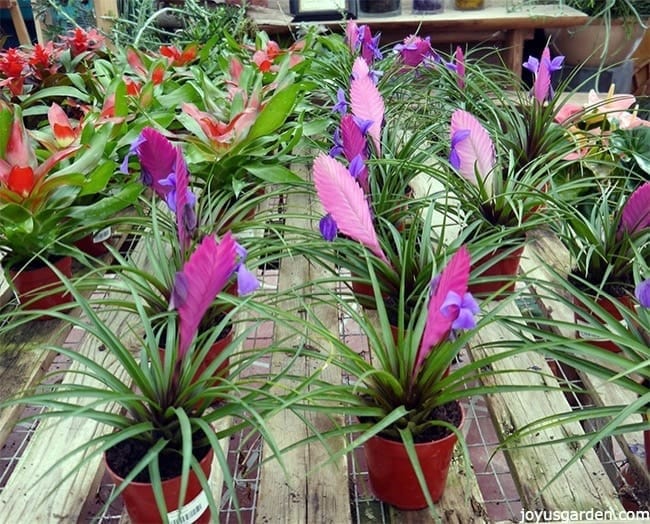
Light Requirements
Bright natural light is best for your Pink Quill Plant. Near but not in an east, south, or west window is fine. You want it in this light exposure to bring on the flowering and have the plant look its best.
This plant will tolerate lower light levels but will do better and flower better with more.
Conversely, avoid putting it in strong, direct sunlight as the plant will burn.
Watering
This one doesn’t need a lot. They’re epiphytes and, in nature, grow attached to other plants and even rocks. The roots are primarily for anchoring. They get the moisture and nutrients they need through their foliage. Never keep them soggy or let them sit directly in water, as this leads to root rot.
Because moisture is collected through their leaves, they appreciate spraying or misting once or twice a week. I’ve had this sprayer for over three years, and it still works like a charm.
You can give the growing medium a good drink every 1-2 months, depending on the temperatures and the season. Make sure the pot it’s growing in has drainage holes so the excess water can flow out. Like all houseplants, water less often in the late fall/winter months.
If you have hard tap water, consider using purified or distilled water. I use filtered water for all my indoor plants. I have a tankless R/O water filtration system that runs through my kitchen faucet; it has a re-mineralization cartridge that puts the good minerals back in.
Temperature/Humidity
The Pink Quill Plant isn’t too fussy but likes warm conditions. If you’re comfortable in your home, it’ll be too. Two things to note: They like good air circulation. And you want to avoid putting it in any areas with cold or hot drafts.
Bromeliads are native to the subtropics and the tropics (locations with high humidity) but handle the lack of humidity in our homes and offices just fine. If the leaves have a lot of brown tips, it could result from the dry air.
I have this humidity meter in my dining room. It’s inexpensive but does the trick and still works fine after a few years. I run my Canopy humidifiers when the humidity reads low, often in the Arizona desert where I live!
Fertilizing/Feeding
Feed in the spring or summer; twice a year should be enough.
Like other bromeliads, they get their nutrients from matter that falls on them from plants growing above. The roots serve the purpose of anchoring them onto whatever they’re growing on – trees, rocks, etc.
Because they get their moisture and nutrients through the foliage, not the soil, it’s best to use a foliar fertilizer spray on the foliage and the growing medium’s surface.
I feed my bromeliads and air plants twice a year if they need it.
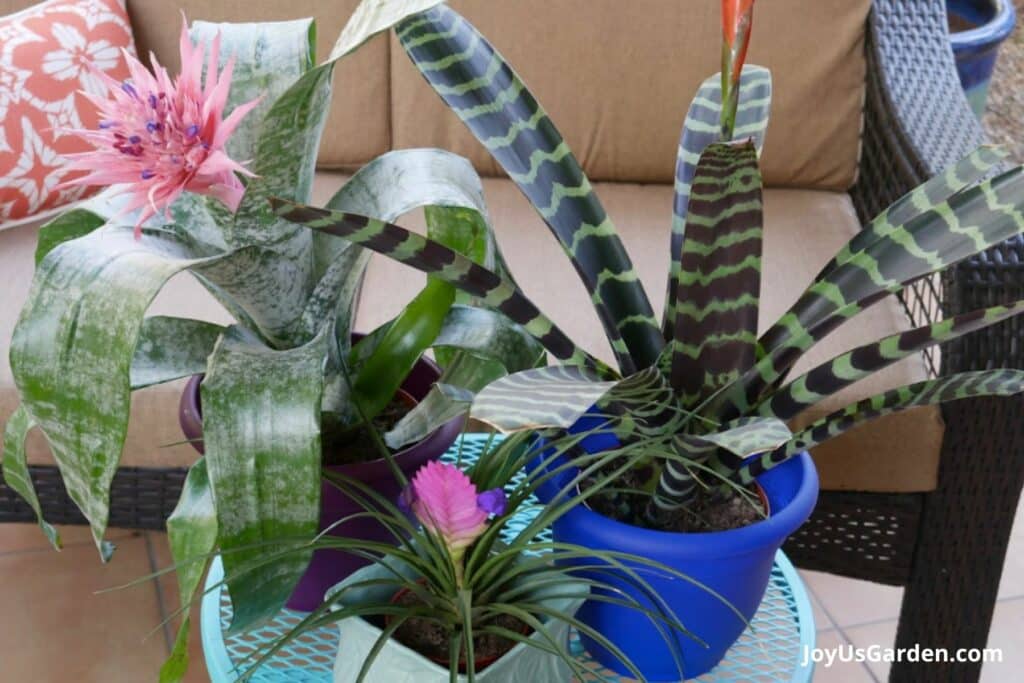
Growing Mix
The Pink Quill Plant, because it’s epiphytic like other bromeliads, needs a mix with excellent drainage. You don’t want it to hold too much water.
They’ll grow fine in a mix formulated for bromeliads or orchid mix. I’ve planted them in 1/2 coco chips (or orchid bark) and 1/2 coco coir, a more sustainable replacement for peat moss.
Another blend I’ve used for bromeliads is 1/3 potting soil, 1/3 pumice, and 1/3 coco chips. The choice is yours!
Repotting
Pink Quills don’t have extensive root systems, so yours will likely never need to be repotted. If you need to, spring, summer, and early fall are the best times.
This is a small plant, so using a small pot will be fine. The single plants I’ve seen typically growing in 4″ pots.
If you’re interested in kokedama, the Pink Quill Plant suits this Japanese art of displaying plants well.
Propagation
Pink Quill pups (babies, offsets) form at the base of the plant. Like other bromeliads, this is how you propagate this plant.
The mother plant will eventually die after flowering. This isn’t your fault; it’s just the natural cycle bromeliads go through. The pups will start forming before this happens or just after.
You can leave them attached to the mother and cut the dead foliage off, or remove the pups and plant them into another pot.
By the way, it takes at least three years for the pups to flower, maybe even longer.
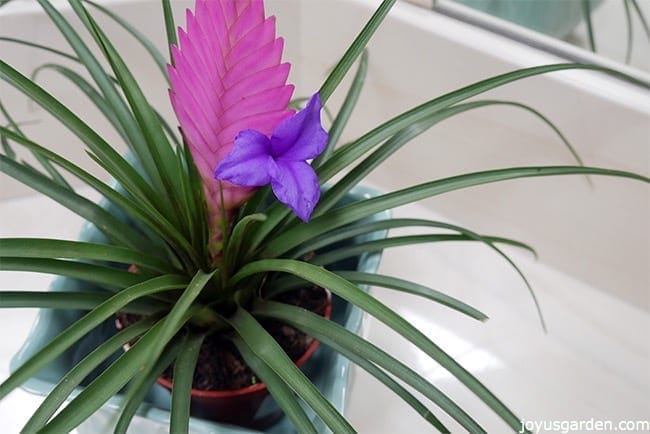
Safe For Pets
I haven’t heard anything about these being toxic to cats or dogs. According to the ASPCA, Guzmania plants (another bromeliad relative) are considered non-toxic for cats and dogs.
However, some kitties like to chew on their crunchy leaves, so if yours does, you might want to keep your eye on that. It won’t poison them, but it could make them sick.
Pink Quill Flower
This is what makes this plant so favored! The flower spikes produce pink bracts, and the violet-blue flowers appear off those.
The pink quill can last 2-4 months, but the vivid flowers last a few days. From my experience, only 1-3 flowers are open on the plant simultaneously.
The pink quill will fade with time and eventually turn greenish before dying (more on this in “propagation”). Once it’s gone, you can cut it off.
If the flowers on yours are not opening up, it’s most likely not getting enough light. This plant needs bright light for the blooms to open up.
Pink Quill Plant Care Video Guide
Pink Quill Plant Care FAQs
The rich blue/purple flowers that appear off the quill’s sides are short-lived. I’ve found they open no more than a few at a time and only last a few days. The good news is that the pink quill can last for up to 4 months.
Not much. It’s better to spray these plants 2-3 times a week rather than water the growing mix every week.
Yes and no. The parent plant dies once it flowers, but the pups that form at the base live on.
The pink quill, which is the inflorescence and not technically the flower, is the main draw for this plant.
Be sure to try the Pink Quill Plant – this popular bromeliad houseplant is so easy that it practically maintains itself!
Happy gardening & thanks for stopping by,


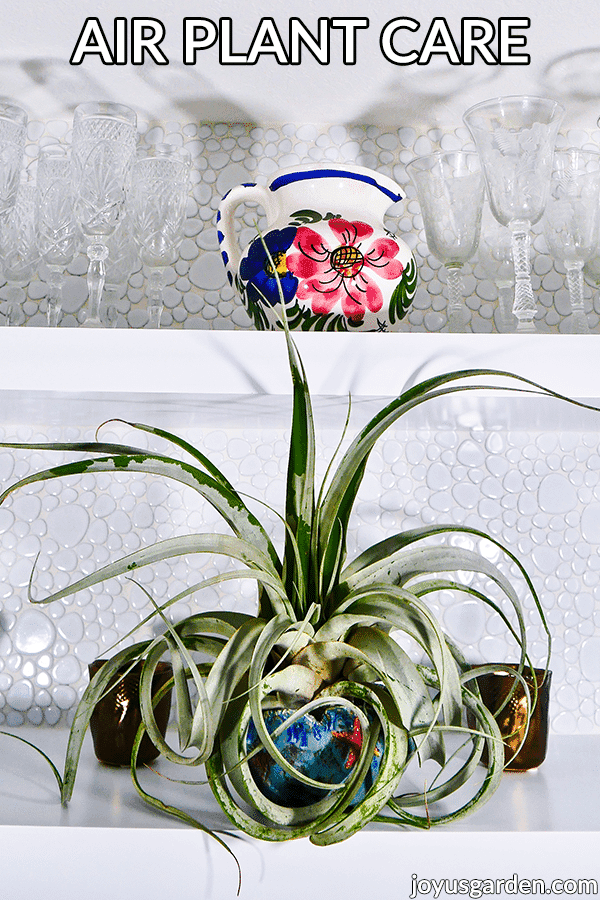
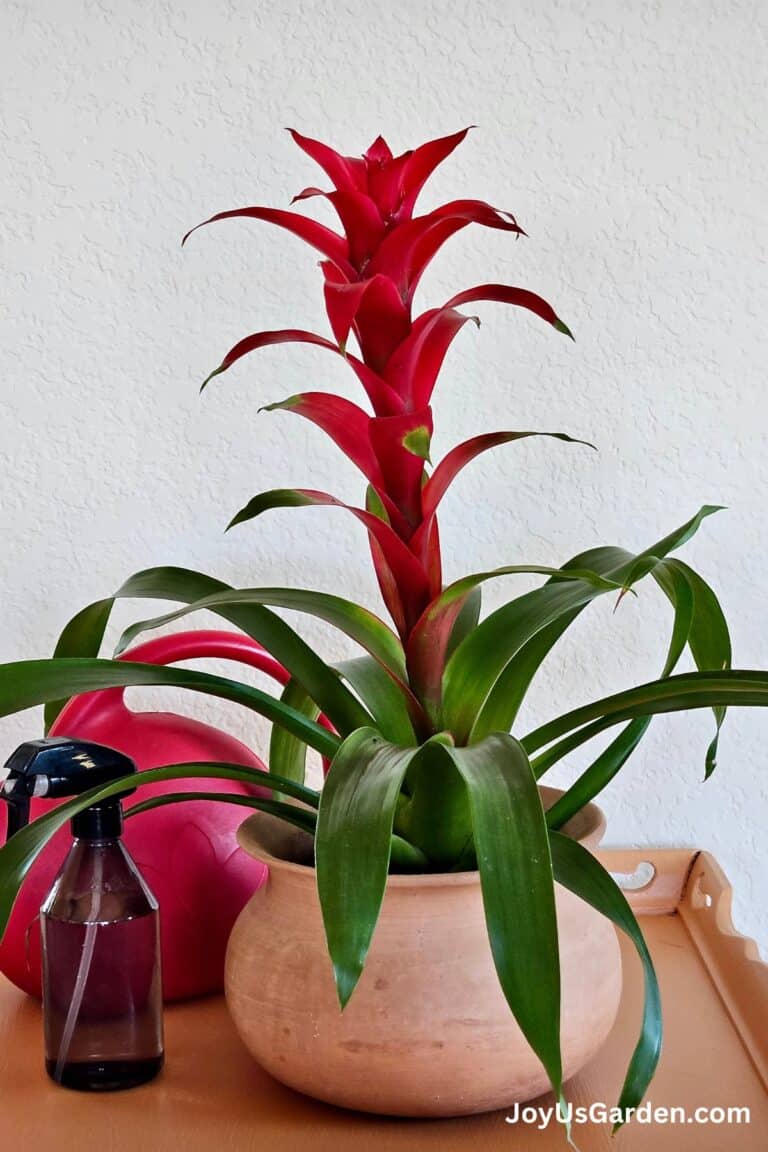
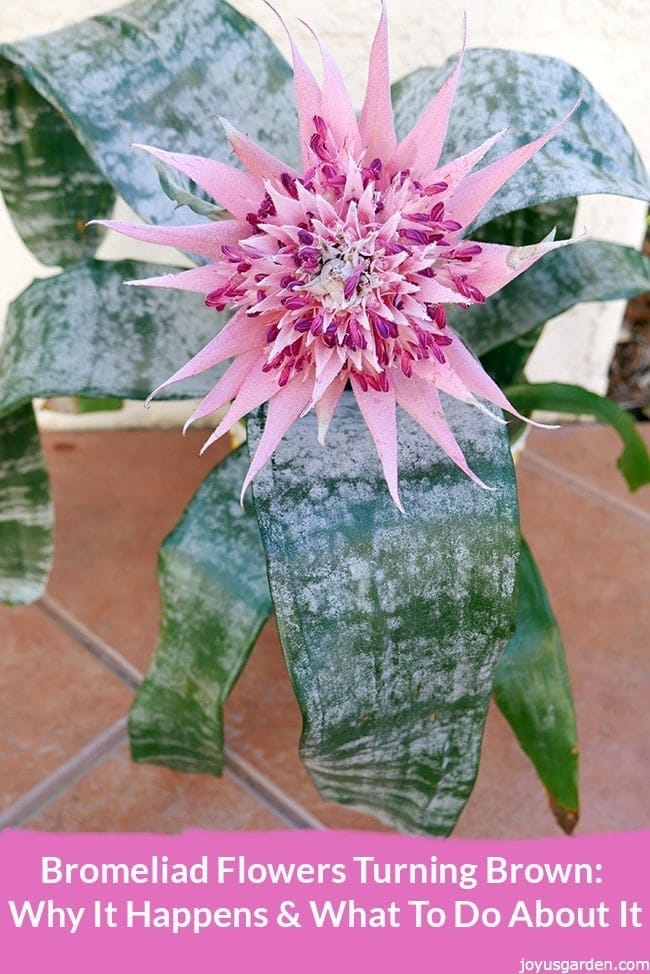
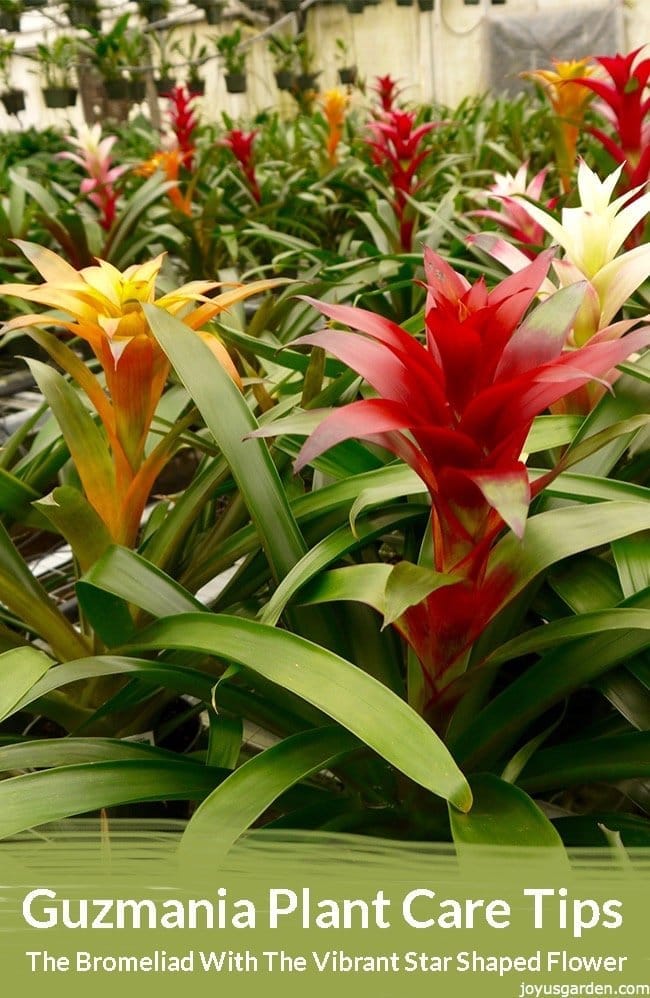
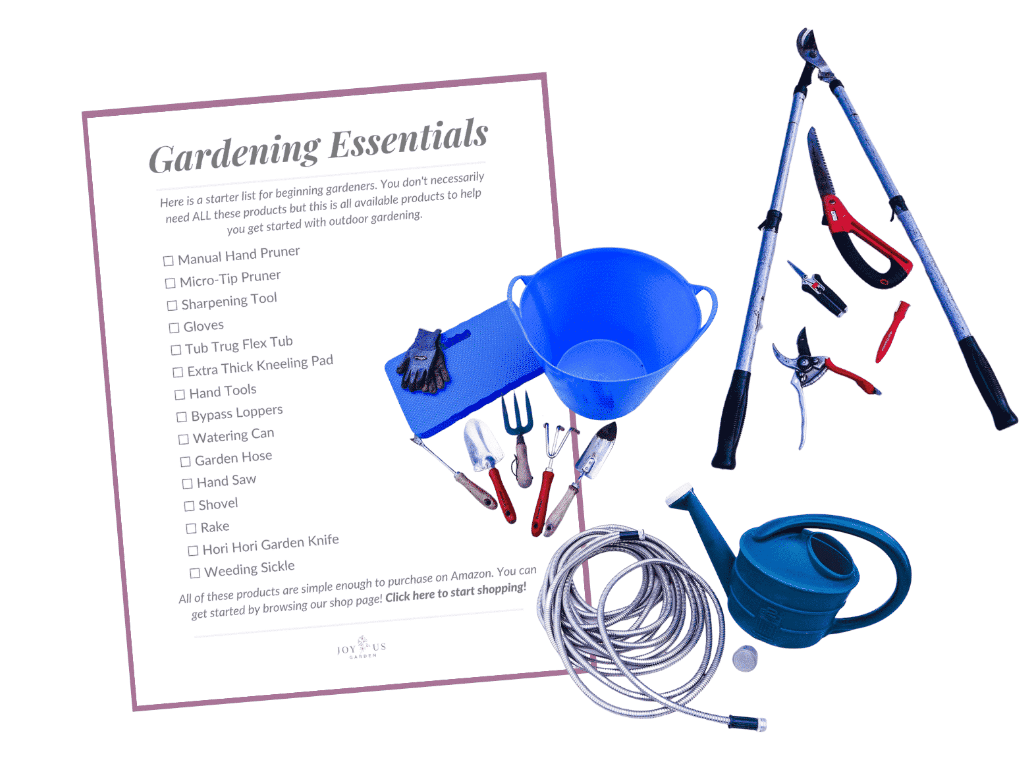
I have one a it’s beautiful! Now, I’m waiting for the pups. I will let then in the mother’s soil and then I’ll just cut out the mother. I hope I’ll do this rightly. Thanks for this text. <3 Jana
Thank you for your video and the written info. Bought my mom one for Mother’s Day and today she told it has purple flowers on the quill. Sent her the link to your website, which I know she will enjoy.
Hi – Thank you for passing the info on! My quill turned green a few months ago but still looks great. The purple flowers are short lived but very pretty. Nell
My pink part is fading into a green color – any idea who why? I have only had it 1 month
Yes Bree, it’s because the quill is starting it’s dying out process. Mine stay green for at least a month or 2 so you’ll have some time before you need to cut it off. Nell
Hi Nell,
I got a till, Cyanea from my sisters house ( she passed away) and I need to know how to take care of this plant. I pink quill is going dark( I hope it’s not dying)so I need you to help me take care of this plant
Hi Linda – Sounds like your quill is going through the dying process. When it’s brown, cut it all the way back. How to care for it is in the blog post. Nell
Great info – many thanks 🙂
You are certainly welcome! Nell
Hi there!
Got this plant when I was visiting Hawaii this summer. I was told to water it twice a week and have been doing so. The pink quill grew flowers that eventually all died but now the quill is dried out and brown, quite dead. Is this the part I should cut off and if so, how far do I cut? Also, how long will this plant live?
Hi Katelyn – Cut the flower stalk off completely; down into the cup. It’s hard to say how long the mother plant will live for you but I’ve have it look good for 6 months after the flower dies. The leaves gradually turn brown & then the plant dies. The pups live on though. More info here: https://www.joyusgarden.com/bromeliads-101-a-round-up-of-our-care-posts/ Nell
Hi there!
Is it normal that the flowers do not fully bloom? There seems to be a lot on the quill, but thy die before they bloom.
Thanks!
Hi Jules – The flowers are short lived & usually open 1 or 2 at a time. The plant may not be getting enough light. Nell
Hi Nell. Thanks for the info. Love my Pink Quill. I keep seeing Pink Quill seeds being sold online. How can I get mine to seed? Thank you.
You’re welcome Karen. I don’t know much about that because I always propagate mine by the pups. I do know that it can be challenging to get the seeds to grow. Nell